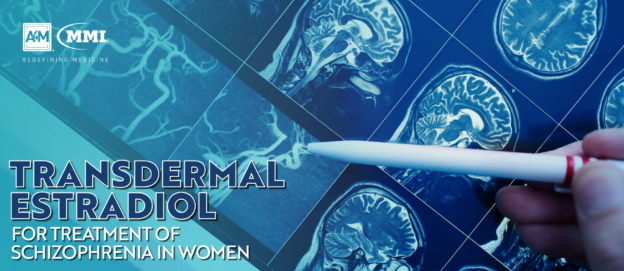One of the top causes of disability across the globe, schizophrenia can significantly diminish educational, occupational and psychosocial performance, impairing the lives of millions of people worldwide. Although the severe chronic neurological disorder affects a small proportion of the population – around 1% – it is one of the most disabling conditions, especially if left untreated. Schizophrenia carries a substantial disease burden; people with the disorder face increased risks of premature mortality, suicide, and physical illness.
While research has yet to identify a definitive cause of schizophrenia, many factors are thought to contribute to the development of schizophrenia, including genetics, environment, and neurological changes. Previous research implicates that estrogen may play a significant role in the condition’s progression, with a prior randomized controlled trial revealing symptom improvement in premenopausal female patients treated with transdermal estradiol. These initial positive findings have not been replicated by other studies, including ones without commercial involvement.
A recently published randomized controlled trial aimed to replicate previous results and extend current understanding of the connection between transdermal estrogen treatment and schizophrenia symptom improvement. The study’s findings, published in JAMA Psychiatry, suggest that adjunctive estrogen patches may significantly improve both positive and negative symptoms of the disorder in women of childbearing age.
Effect of Adjunctive Estradiol on Schizophrenia in Premenopausal Women
Lead investigator Dr. Mark Weiser of Sheba Medical Center and Tel Aviv University, and his colleagues examined the effect of transdermal estradiol as an adjunctive therapy to antipsychotic medication in women of childbearing age with schizophrenia. Researchers analyzed data from a cohort of 200 premenopausal women with a mean age of 38 years from the Republic of Moldova; all participants had schizophrenia or schizoaffective disorder and were being treated pharmacologically.
A minimum Positive and Negative Syndrome Scale (PANSS) score of 60 was required. At baseline, the PANSS score was nearly 83, with a mean PANSS positive sub-scale score of 19.6 – which indicated severe symptoms. Positive schizophrenic symptoms include delusions and hallucinations, while negative symptoms can range from lack of initiative to poor social skills. Using the PANSS, each symptom is rated from 1 to 7 where 1 is normal.
Twelve participants did not complete the full study, while the rest of the cohort was randomly assigned either a 200-μg estradiol patch or a placebo adjunct to antipsychotic medication. After 8 weeks of treatment, PANSS scores were re-measured and revealed significant improvement in both cohorts. The mean PANSS positive sub-scale score was reduced to 14.4 in the placebo group and 13.4 in the estradiol group; although the difference between cohort results is small, it was statistically significant. In addition, the estradiol group had a greater drop in PANSS total score, effect size, as well as the PANSS sub-scales of negative symptoms and general psychopathology.
Greater Response to Treatment in Older Participants
Dr. Weiser and his team noted a statistically significant greater response to the treatment in women over the age of 38 with an effect size of 0.79 on the positive PANSS sub-scale score. Meanwhile, estradiol did not have a significant effect on younger women. The clinical significance of the results for women aged between 38 and 45 prompted investigators to conduct another randomized trial of transdermal estradiol treatment for this age group.
Implications of the Latest Findings
The substantial improvements in both the positive and negative symptoms went beyond the effects of antipsychotic therapy alone and underscore the promising nature of transdermal estradiol as an adjunctive therapy. According to investigators, the effect sizes can be considered somewhat significant from a clinical perspective. There were also considerate improvements in the estradiol treatment group compared with the placebo group in Clinical Global Impression – Severity and Montgomery Depression Scale scores. The new findings suggest that estrogen patches should be considered as a treatment option for premenopausal women with schizophrenia, Dr.Weiser told Medscape Medical News in an interview.
Despite the limitations of the study, which did not determine the durability of the effects after treatment was discontinued and tested a relatively low dosage of estradiol, the team’s findings confirm previous trial results, implicating that estrogen patches may have therapeutic effects in schizophrenic women of childbearing age. However, estrogen therapy carries several health risks and may contribute to an increased likelihood of breast cancer in patients, which requires a thorough evaluation of the risk to benefit ratio for this type of treatment. Critics take issue with the degree of statistical improvement, theorizing that the results may carry little clinical meaning. As a result, further research is needed to evaluate the true scale of symptom improvement in women with schizophrenia.

